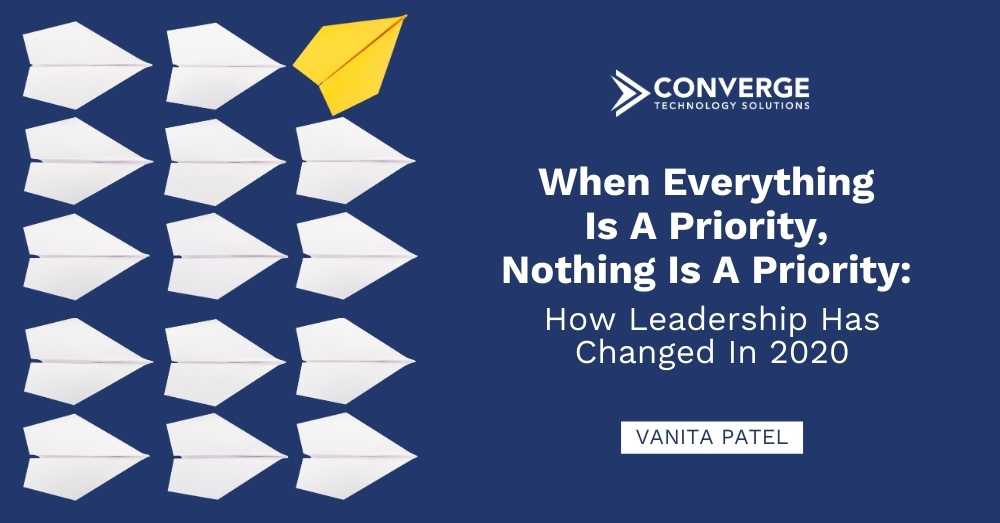It goes without saying that COVID-19 has changed the lives of millions across the world. With many of us already being pulled in so many directions, the pandemic has only amplified our workloads, both personally and professionally. As leaders, it has never been more important to calmly and intelligently navigate the impact that COVID-19 has had on our businesses.
For me personally, I am used to juggling a career and being a mom, but in light of recent events, I am now also an educator for my two teenage boys. When I am lucky enough to find spare time, I find myself watching home organization shows like ‘Get Organized with The Home Edit’ and ‘Tidying Up with Marie Kondo.’ For those of you who haven’t joined these cults, both shows feature a central personality whose commitment to a manner of housekeeping feels completely unrelatable at its extremes. One show is all about shedding items that no longer spark joy while the other about showcasing everything you own in curated, beautiful, perfectly-sized containers.
During the pandemic, I took it upon myself to organize my pantry. Not solely because of the shows I had watched, but rather for my two teenage boys (and my sanity). After seven months of being together day and night, I learned that the most popular room in the house is the pantry. All day long the pantry door is wide open – I like to think of it as a convenience store at the all-inclusive resort that my kids call home. I started to find myself obsessing over these Instagram photos of the perfect placement of items, the calligraphy on the container labels, and the basket/container shapes I could put in there. I was spending time wondering how I could reorganize my pantry, searching Pinterest looking for ideas, and it started to become overwhelming. It was at this point that I realized when everything is a priority, nothing is a priority.
Changing business priorities
Today, that concept has never been truer. Just two years ago, few executives would have prioritized the need for skills and competencies in crisis management, agility, and workforce resiliency. These would not have been deemed critically important; now, however, we are leaning on digital transformation to tell a different story. Competitiveness and resiliency have become key drivers as organizations move more and more workers to remote platforms, revamp the supply chain, and make manufacturing shifts like producing PPE equipment. Additionally, old business barriers are being brushed aside as customer demands and market disruptions are brought to the forefront. Changes like these require adaptability, speed, and flexibility.
The motivation to transform is no longer aspirational but essential. The pandemic has permanently changed organizational strategies and approaches to change management have to be adjusted. Before 2020, many organizations seemed to distrust their own technological capabilities and even doubted the skills of their own workforces. Interestingly, those anxieties have proved to be largely unfounded. The reliance on technology platforms and the teams that deliver results on them have become more acute. It’s not that companies suddenly went out and researched new technologies to build and deploy a remote workforce in a short window. Rather, they actually leveraged the tools they already had, people and technology, to their fullest potential.
A recent survey by the Institute for Business Value reported that 64% of respondents acknowledged a shift to more cloud-based activities. *Can we link this?* Executives learned to be more trusting of what technology can do and, interestingly, are now requesting more digital transformation initiatives. They see the value!
The human element is the key to success
At Converge, I have the opportunity to have conversations about the previously noted shifts in business with our clients and sales teams. It’s not only the IT teams that are cheering for technology, but also the leadership teams, who are embracing the benefits. In order to employ these new technologies, we need to ensure our people are capable, adaptable, and resilient for the next leg of the journey.
Leadership is not only about taking charge and steering the ship. It is also about building an organization where everyone is an innovator. So, as we talk about the human element, it is necessary to separate it into two categories:
First, our clients. We are all faced with this new reality of customer buyer behavior and how it will change post-COVID. As businesses begin to transact more online customer experiences, the management of those experiences will become a growing priority for the survival of any business. Despite this fact, research shows that improved customer service still sits at the bottom of the list that executives prioritize when taking on their digital transformation projects. Clients are demanding the acceleration of the redesign and integration of the customer digital experience across the enterprise including high specificity, individuality, and the brand’s personality with overall satisfaction of the entire journey at the core. Even after we reestablish face-to-face business, customers are now accustomed to the speed that the virtual engagement format has provided, reiterating the point that incorporating enhanced customer services into our digital transformation journey is not aspirational, but essential.
Second, being an employee. While workplace safety, flexibility, and skills are important to the success of the organization, the data shows that employee satisfaction is still suffering, stating that only half of the employees believe their employer is generally concerned about their welfare. While leadership understands the significant amount of pressure employees face, we often overestimate the level of support and training that our employees receive. This time is an opportunity for leaders to close this “trust gap”. With the maniacal focus on cost reduction and implementation of artificial intelligence to complete mundane tasks, the workforce at home is already in fear of being replaced. Additionally, working from home has put a strain on our personal connections, which is oftentimes the lifeblood of our corporate culture. Empowering a healthy workforce goes beyond giving employees the best network access or group meeting software. It requires a healthy culture to help equip employees to work productively outside the network office. The role of leaders is to build trust, flexibility, and resiliency in an adaptable workforce culture where we are helping our employees be the best version of themselves.
What opportunities lie ahead?
As executives and leaders, we must not lose sight of the human impact of our effort to increase our competitiveness in the industry, because those efforts are the source of tomorrow’s innovations. It is critical to building a diverse workforce based on trust and confidence: One that emphasizes optimization rather than employee burnout. Rely on the resourcefulness of your team. While there is so much unknown, there is no right way – only a mix of ever-evolving possibilities and our conviction to create a better future. At the end of the day, how our employees are treated today will have an overwhelming impact on the success of our organizations in the future. This crisis will pass, but what happens next is up to us and, as leaders, we can hold each other accountable on how best to get there.




